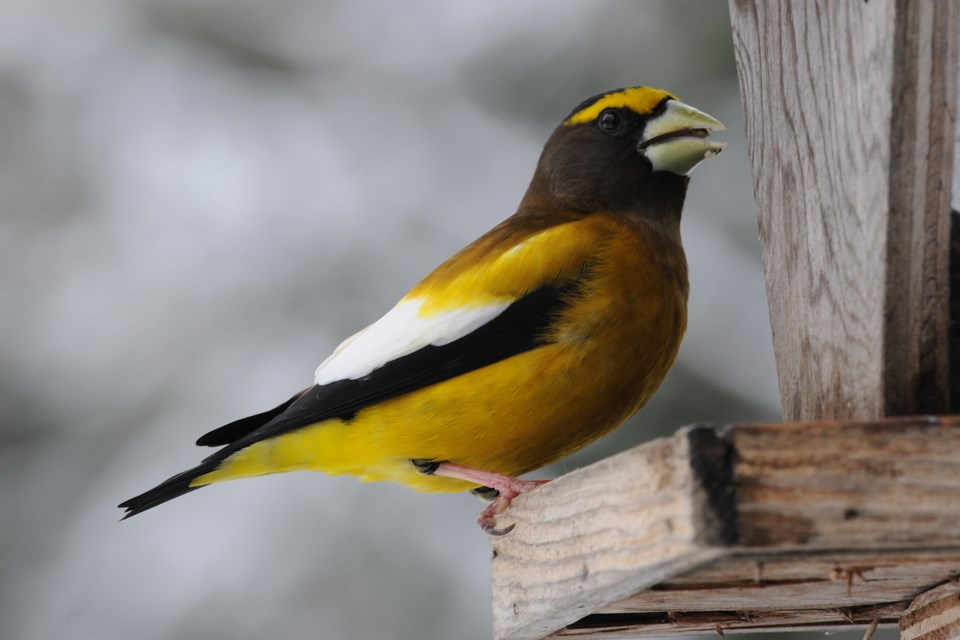They're back! Well, in some places anyway.
Evening grosbeaks are rather commanding in appearance and when they hit your feeding station, you notice them. Gregarious and quarrelsome, a flock of these birds can provide entertaining viewing as they vie for perch space and who can grab the most sunflowers seeds.
This is a species that has what bird watchers call "winter irruptions," in that some years these brightly coloured birds are absent and other years you can go to the edge of bankruptcy buying sunflower seeds for them. And when the evening grosbeaks show up, often tagging along are their cousins, the pine grosbeak and a smattering of smaller finch species.
In the mid-1960s our first backyard bird feeder in Orillia attracted these birds, along with a few blue jays and chickadees. I was 10-years old and upon seeing these brilliantly coloured birds on the other side of the kitchen window, I was hooked on bird watching.
For many years following it was the arrival of the evening grosbeaks that became the highlight of the winter.
However, within 30 years these birds began to become scarce, with some winters being devoid of a single grosbeak anywhere in southern Ontario. What's up with that? This was to become an example of scientific curiosity for many people, and the answer for the decline was unsettling.
But first, a bit of background on this bird of the bright yellow plumage.
Evening grosbeaks are originally a western bird with the Colorado River Basin being their home base. In the early 1800s there are records of these birds being in high numbers residing within the firs and pines of that region. For reasons unknown they then started an eastward extension of their range.
According to the Birds of Simcoe County book compiled by O. E. Devitt, the first local record of an evening grosbeak was in Barrie on 24 May, 1886. By 1890 they had become a common sighting, with that year being noted as "the winter of the great incursion into southern Ontario and the New England states."
One of the factors thought to be behind this arrival was the concurrent introduction of a new tree species from the Red River Valley, the Manitoba maple.
There are actually two tree species that the evening grosbeak is closely tied to, the Manitoba maple for a winter seed supply, and the black spruce of northern Ontario for a summer nesting area. And herein lies part of the answer to the fluctuating population of this bird.
From 1940 to the 1970s an insect called the spruce budworm was rampant in northern Ontario, and these protein rich insects fed many evening grosbeaks.
Starting in the 1980s the forest industry began an extensive aerial spray program to control these tree munching insects, and it worked too well. Not only did the spruce budworm get knocked back, so too did all the other forest insects. No food for the grosbeaks meant that very few young birds survived.
When the 1968 population was compared to the 2015 population, there was a 97% reduction! Along with the loss of food came a couple diseases that targeted finches, and the spread of salmonella, West Nile, and purple finch eye disease took a toll on the weakened birds.
Yet a small population of evening grosbeaks held on, and as the spruce budworm is recovering within its own 40-year cycle there are now enough birds to once again be noted at our winter bird feeders.
However, in August of 2018 (ahh... August... warm weather, sunshine... oops, I digress) the Ontario Ministry of Natural Resources and Forestry added the evening grosbeak to their notorious Species At Risk, listing it as a Special Concern due to the very low population numbers.
As climate change effects set in, one of the tree species indicating that it cannot maintain its current status is the spruce. If the spruce trees die back or shift their growing range, the insects that feed on them will be affected and the birds that eat the insects will be affected and the diversity of birds that overwinter in Ontario will be affected. So maybe you don't have to buy so much bird seed. Hmm... that's not a good thing.
If you have luck this winter to view evening grosbeaks, or pine grosbeaks, consider the bigger picture. These birds are literally "the canary in the coal mine"; if they have to struggle to survive, perhaps our fate is not too far behind.



